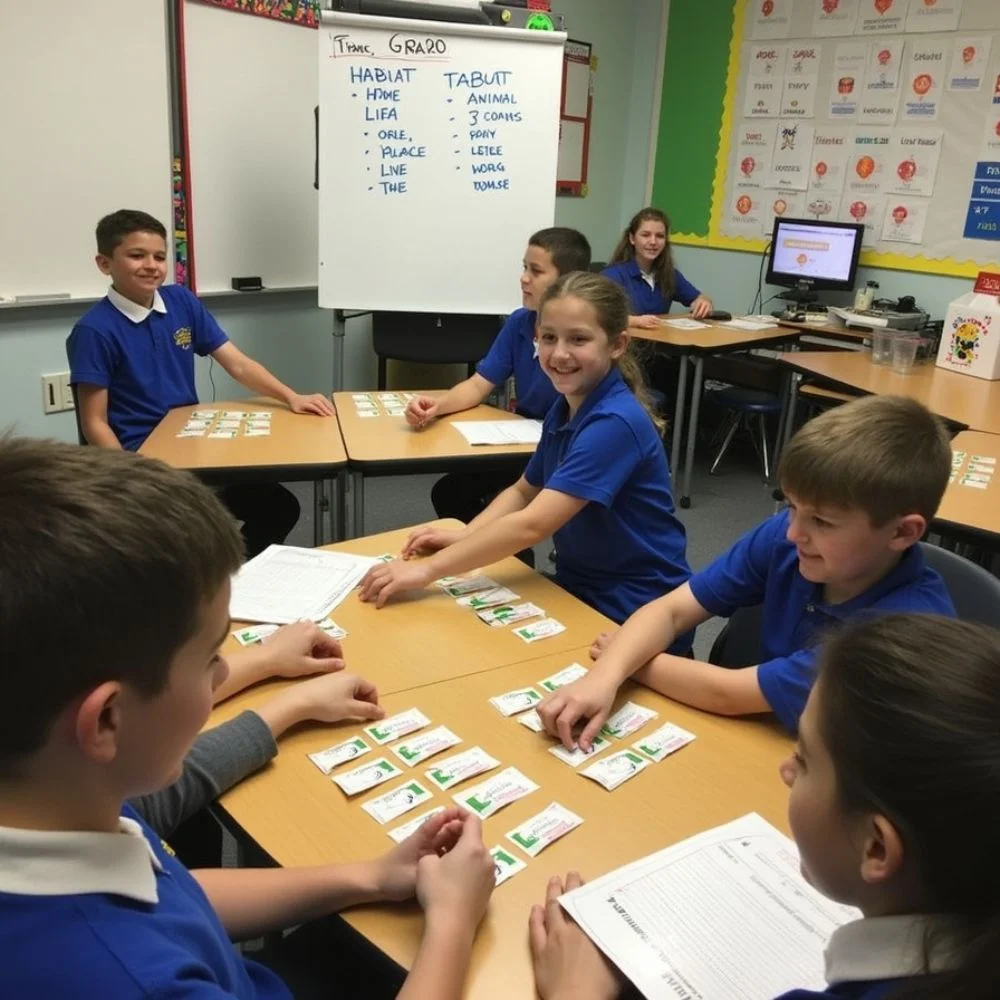Table of Contents
What Is the Taboo Game?
Taboo is a word-guessing game. The goal is to make your team guess a target word without using a set of “taboo” words that are closely related to it.
For example, if the word is “apple”, the taboo words might be fruit, red, tree, pie, and round. The player must describe the word without using any of these five related words. This makes the game challenging and fun.
Why Use Taboo in a Grade 6 Classroom?
Grade 6 is a time when students are learning more complex words and ideas. They are also developing better communication and teamwork skills. The Taboo game supports all of these goals.
Here’s why it works well in learning:
- Builds vocabulary: Students hear and use a variety of words while playing.
- Boosts speaking skills: Students practice describing ideas clearly.
- Encourages teamwork: They work together to win the game.
- Improves listening skills: Players must listen carefully to clues.
- Makes learning fun: It brings energy and laughter into the classroom.
Planning Your Taboo Lesson
To make Taboo effective in your Grade 6 classroom, good planning is key. It helps students stay engaged while learning actively through play.
1. Choose the Right Words
Start by selecting vocabulary from your current unit. This keeps the game relevant and meaningful. For a science lesson, you might use words like photosynthesis, evaporation, or habitat. In social studies, try democracy, culture, or tradition. For math, use terms like fraction, multiplication, or perimeter. After choosing your target words, write 3–5 related words that students are not allowed to say these are the “taboo” words.
Example:
- Target word: habitat
- Taboo words: home, animal, place, live
2. Set the Rules
Explain the game rules in a simple way so everyone understands. Students must describe the target word without saying any taboo words or parts of those words. They can’t spell, give clues using hand signals, or act. Set a time limit, 30 seconds, 1 minute, or 2 minutes works well. If a taboo word is used, the turn ends immediately.
3. Group Students
Put students in pairs or small groups of 3–4. Try to mix skill levels so everyone can learn from each other. This encourages teamwork and communication.
4. Prepare Materials
Have everything ready: Taboo cards (on a ring or shuffled), a timer, a score sheet if you want to keep points, and a clear space or board for playing. A little prep goes a long way in making your lesson fun and smooth.

Running the Game in Class
1. Step‑by‑step plan
- Explain the rules clearly, with an example card.
- Do a demo round with volunteer students so everyone understands.
- Play the game, rotating each team and timing each turn.
- Briefly review a few cards after each round to reinforce the words.
- Wrap up by reviewing the words used in all cards and asking students to use them in a sentence.
2. Tips for Smooth Play
- Keep the pace steady, but don’t rush beginners.
- Use positive praise, not criticism.
- The PT time or clues for mixed ability.
- Include all students; let shy ones describe or guess.
- Keep switching who describes and who guesses.
Variations and Extensions
Taboo is a flexible game that can be changed in many ways to fit your classroom needs, learning goals, and student preferences. These variations add fun, creativity, and different learning styles to your lessons.
1. Team vs. Team
Split the class into two teams. Each team takes turns, playing for one minute while the other team watches. Keep score to add a light competition element. This version motivates students to do their best while building teamwork and focus. Students love cheering for their team, which keeps the energy high and the learning fun.
2. No Points, Just Play
Sometimes, students may not enjoy competition or may feel stressed by scoring. In this version, remove the points and let students simply enjoy the game. Focus on speaking clearly, listening carefully, and learning new words. This is great for early rounds or when you want to keep things relaxed.
3. Written Taboo
Instead of speaking, students can use the Taboo cards as writing prompts. They write a short description of the target word without using the taboo words. This helps improve their writing skills and vocabulary understanding, especially for students who are shy or quiet.
4. Class-Wide Charades
One student comes to the front and silently acts out the target word while the rest of the class guesses. This version combines movement with thinking and is great for kinesthetic learners. It also adds variety and laughter to your class.
5. Digital Taboo
Use slides, PowerPoint, or apps to display the cards. This is perfect for smart classrooms, blended learning, or online classes. You can also find or make digital Taboo card decks and use timers or buzzers online for smoother play.
6. Student-Created Cards
Let students make their own Taboo cards using vocabulary from the unit. This activity deepens understanding as they must think carefully about the word’s meaning and related words. It also gives them a sense of ownership and creativity in their learning.
Common Challenges & Solutions
| Challenge | Solution |
| Students say taboo words by mistake | Gently stop the round and move on. Emphasize learning over errors. |
| Mixed ability causes an imbalance | Mix students with different skill levels, or adapt the time. |
| Dominant students take over | Rotate roles; ensure each voice is heard. |
| Time runs out before guessing | Shorten the word list or give a clue to earn partial credit. |
Bringing It All Together
Taboo works best when it’s:
- Well planned: choose the right words, clear rules, ready materials
- Purposeful: tied to lessons, not just for fun
- Inclusive: supports diverse learners
- Reflective: includes review and feedback
- Fun: energy, smiles, and encouragement
Sample Lesson Plan
- Warm-up (5 min): Quick vocabulary matching.
- Introduce Taboo (5 min): Explain rules and show an example.
- Demo round (5 min): Teacher or volunteers show how it’s done.
- Play (20 min): 3–4 rounds in groups, switching describer/guessers.
- Review (10 min): Go over all target words, use them in sentences.
- Cool-down (5 min): Students say one new word they learned.
Conclusion
Using the Taboo game in Grade 6 classrooms is a powerful way to teach vocabulary, build fluency, encourage cooperation, and boost confidence all while making learning fun and active. Research supports its benefits for motivation, speaking, participation, and memory. With simple prep, clear rules, and positive energy, any teacher can make Taboo a stand‑out activity that students love and learn from. By planning carefully, adapting to student needs, measuring results, and keeping the atmosphere upbeat, Taboo can transform a classroom into a vibrant learning space where students speak up, smile, and truly grow in language skills.
Also read this: Exploring Educational Games








